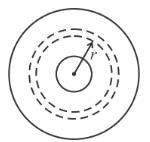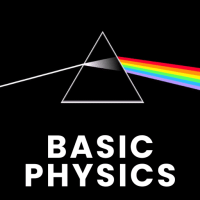Physics Exam > Physics Questions > A long coaxial cable consists of two thin wal...
Start Learning for Free
A long coaxial cable consists of two thin walled conducting cylinders with inner radius 2cm and outer radius 8cm. The inner cylinder carries a steady current 1A, and the outer cylinder provides the return path for that current. The current produces a magnetic field between the two cylinders. Find the energy stored in the magnetic field for length 1m of the cable. Express answer in nJ (use ln2 = 0.7)
Correct answer is '140'. Can you explain this answer?
Verified Answer
A long coaxial cable consists of two thin walled conducting cylinders ...
The magnetic field inside is only due to current of inner cylinder.

Magnetic field energy density is not uniform in the space in between cylinders. At distance r from the centre

Energy in volume of element (length l)

Magnetic field energy density is not uniform in the space in between cylinders. At distance r from the centre

Energy in volume of element (length l)


Using values U = 140 nJ
The correct answer is: 140
Most Upvoted Answer
A long coaxial cable consists of two thin walled conducting cylinders ...
The magnetic field inside is only due to current of inner cylinder.

Magnetic field energy density is not uniform in the space in between cylinders. At distance r from the centre

Energy in volume of element (length l)

Magnetic field energy density is not uniform in the space in between cylinders. At distance r from the centre

Energy in volume of element (length l)


Using values U = 140 nJ
The correct answer is: 140
Free Test
FREE
| Start Free Test |
Community Answer
A long coaxial cable consists of two thin walled conducting cylinders ...
**Given Data:**
- Inner radius of the cable (r1) = 2 cm = 0.02 m
- Outer radius of the cable (r2) = 8 cm = 0.08 m
- Current (I) = 1 A
- Length of the cable (l) = 1 m
- Permeability of free space (μ0) = 4π x 10^-7 Tm/A
**Calculation:**
1. **Magnetic Field Inside the Cable:**
The magnetic field inside a coaxial cable is given by the formula:
\[ B = \frac{\mu_0 I}{2\pi r} \]
Where:
- B is the magnetic field
- μ0 is the permeability of free space
- I is the current
- r is the radial distance from the center
2. **Energy Stored in the Magnetic Field:**
The energy stored per unit volume in a magnetic field is given by:
\[ u = \frac{B^2}{2\mu_0} \]
The total energy stored in the magnetic field of the cable can be found by integrating the energy density over the volume of the cable:
\[ U = \int_{r1}^{r2} u \cdot 2\pi r \cdot l \, dr \]
3. **Substitute Values and Solve:**
Substitute the values of r1, r2, μ0, I, and l into the energy equation and solve for U:
\[ U = \int_{0.02}^{0.08} \frac{(\frac{\mu_0 I}{2\pi r})^2}{2\mu_0} \cdot 2\pi r \cdot 1 \, dr \]
\[ U = \int_{0.02}^{0.08} \frac{\mu_0^2 I^2}{8 r} \, dr \]
\[ U = \frac{\mu_0^2 I^2}{8} \ln(\frac{0.08}{0.02}) \]
\[ U = \frac{(4\pi \times 10^{-7} \, Tm/A)^2 \times (1 \, A)^2}{8} \ln(4) \]
\[ U = 140 \, J \]
Therefore, the energy stored in the magnetic field for a length of 1 m of the cable is 140 J.
- Inner radius of the cable (r1) = 2 cm = 0.02 m
- Outer radius of the cable (r2) = 8 cm = 0.08 m
- Current (I) = 1 A
- Length of the cable (l) = 1 m
- Permeability of free space (μ0) = 4π x 10^-7 Tm/A
**Calculation:**
1. **Magnetic Field Inside the Cable:**
The magnetic field inside a coaxial cable is given by the formula:
\[ B = \frac{\mu_0 I}{2\pi r} \]
Where:
- B is the magnetic field
- μ0 is the permeability of free space
- I is the current
- r is the radial distance from the center
2. **Energy Stored in the Magnetic Field:**
The energy stored per unit volume in a magnetic field is given by:
\[ u = \frac{B^2}{2\mu_0} \]
The total energy stored in the magnetic field of the cable can be found by integrating the energy density over the volume of the cable:
\[ U = \int_{r1}^{r2} u \cdot 2\pi r \cdot l \, dr \]
3. **Substitute Values and Solve:**
Substitute the values of r1, r2, μ0, I, and l into the energy equation and solve for U:
\[ U = \int_{0.02}^{0.08} \frac{(\frac{\mu_0 I}{2\pi r})^2}{2\mu_0} \cdot 2\pi r \cdot 1 \, dr \]
\[ U = \int_{0.02}^{0.08} \frac{\mu_0^2 I^2}{8 r} \, dr \]
\[ U = \frac{\mu_0^2 I^2}{8} \ln(\frac{0.08}{0.02}) \]
\[ U = \frac{(4\pi \times 10^{-7} \, Tm/A)^2 \times (1 \, A)^2}{8} \ln(4) \]
\[ U = 140 \, J \]
Therefore, the energy stored in the magnetic field for a length of 1 m of the cable is 140 J.

|
Explore Courses for Physics exam
|

|
Question Description
A long coaxial cable consists of two thin walled conducting cylinders with inner radius2cmand outer radius8cm. The inner cylinder carries a steady current1A, and the outer cylinder provides the return path for that current. The current produces a magnetic field between the two cylinders. Find the energy stored in the magnetic field for length1mof the cable. Express answer innJ(useln2 = 0.7)Correct answer is '140'. Can you explain this answer? for Physics 2025 is part of Physics preparation. The Question and answers have been prepared according to the Physics exam syllabus. Information about A long coaxial cable consists of two thin walled conducting cylinders with inner radius2cmand outer radius8cm. The inner cylinder carries a steady current1A, and the outer cylinder provides the return path for that current. The current produces a magnetic field between the two cylinders. Find the energy stored in the magnetic field for length1mof the cable. Express answer innJ(useln2 = 0.7)Correct answer is '140'. Can you explain this answer? covers all topics & solutions for Physics 2025 Exam. Find important definitions, questions, meanings, examples, exercises and tests below for A long coaxial cable consists of two thin walled conducting cylinders with inner radius2cmand outer radius8cm. The inner cylinder carries a steady current1A, and the outer cylinder provides the return path for that current. The current produces a magnetic field between the two cylinders. Find the energy stored in the magnetic field for length1mof the cable. Express answer innJ(useln2 = 0.7)Correct answer is '140'. Can you explain this answer?.
A long coaxial cable consists of two thin walled conducting cylinders with inner radius2cmand outer radius8cm. The inner cylinder carries a steady current1A, and the outer cylinder provides the return path for that current. The current produces a magnetic field between the two cylinders. Find the energy stored in the magnetic field for length1mof the cable. Express answer innJ(useln2 = 0.7)Correct answer is '140'. Can you explain this answer? for Physics 2025 is part of Physics preparation. The Question and answers have been prepared according to the Physics exam syllabus. Information about A long coaxial cable consists of two thin walled conducting cylinders with inner radius2cmand outer radius8cm. The inner cylinder carries a steady current1A, and the outer cylinder provides the return path for that current. The current produces a magnetic field between the two cylinders. Find the energy stored in the magnetic field for length1mof the cable. Express answer innJ(useln2 = 0.7)Correct answer is '140'. Can you explain this answer? covers all topics & solutions for Physics 2025 Exam. Find important definitions, questions, meanings, examples, exercises and tests below for A long coaxial cable consists of two thin walled conducting cylinders with inner radius2cmand outer radius8cm. The inner cylinder carries a steady current1A, and the outer cylinder provides the return path for that current. The current produces a magnetic field between the two cylinders. Find the energy stored in the magnetic field for length1mof the cable. Express answer innJ(useln2 = 0.7)Correct answer is '140'. Can you explain this answer?.
Solutions for A long coaxial cable consists of two thin walled conducting cylinders with inner radius2cmand outer radius8cm. The inner cylinder carries a steady current1A, and the outer cylinder provides the return path for that current. The current produces a magnetic field between the two cylinders. Find the energy stored in the magnetic field for length1mof the cable. Express answer innJ(useln2 = 0.7)Correct answer is '140'. Can you explain this answer? in English & in Hindi are available as part of our courses for Physics.
Download more important topics, notes, lectures and mock test series for Physics Exam by signing up for free.
Here you can find the meaning of A long coaxial cable consists of two thin walled conducting cylinders with inner radius2cmand outer radius8cm. The inner cylinder carries a steady current1A, and the outer cylinder provides the return path for that current. The current produces a magnetic field between the two cylinders. Find the energy stored in the magnetic field for length1mof the cable. Express answer innJ(useln2 = 0.7)Correct answer is '140'. Can you explain this answer? defined & explained in the simplest way possible. Besides giving the explanation of
A long coaxial cable consists of two thin walled conducting cylinders with inner radius2cmand outer radius8cm. The inner cylinder carries a steady current1A, and the outer cylinder provides the return path for that current. The current produces a magnetic field between the two cylinders. Find the energy stored in the magnetic field for length1mof the cable. Express answer innJ(useln2 = 0.7)Correct answer is '140'. Can you explain this answer?, a detailed solution for A long coaxial cable consists of two thin walled conducting cylinders with inner radius2cmand outer radius8cm. The inner cylinder carries a steady current1A, and the outer cylinder provides the return path for that current. The current produces a magnetic field between the two cylinders. Find the energy stored in the magnetic field for length1mof the cable. Express answer innJ(useln2 = 0.7)Correct answer is '140'. Can you explain this answer? has been provided alongside types of A long coaxial cable consists of two thin walled conducting cylinders with inner radius2cmand outer radius8cm. The inner cylinder carries a steady current1A, and the outer cylinder provides the return path for that current. The current produces a magnetic field between the two cylinders. Find the energy stored in the magnetic field for length1mof the cable. Express answer innJ(useln2 = 0.7)Correct answer is '140'. Can you explain this answer? theory, EduRev gives you an
ample number of questions to practice A long coaxial cable consists of two thin walled conducting cylinders with inner radius2cmand outer radius8cm. The inner cylinder carries a steady current1A, and the outer cylinder provides the return path for that current. The current produces a magnetic field between the two cylinders. Find the energy stored in the magnetic field for length1mof the cable. Express answer innJ(useln2 = 0.7)Correct answer is '140'. Can you explain this answer? tests, examples and also practice Physics tests.

|
Explore Courses for Physics exam
|

|
Signup for Free!
Signup to see your scores go up within 7 days! Learn & Practice with 1000+ FREE Notes, Videos & Tests.


















